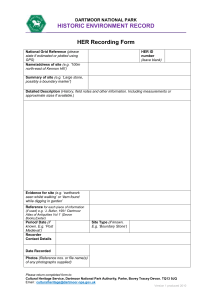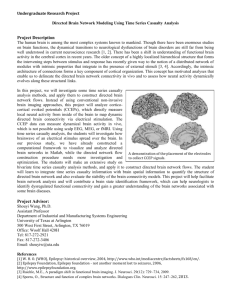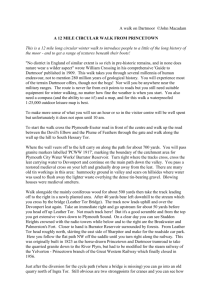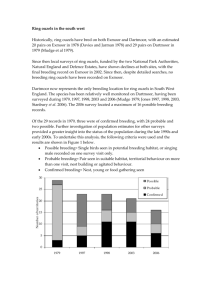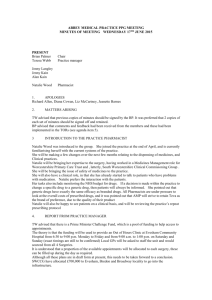Green Card
advertisement
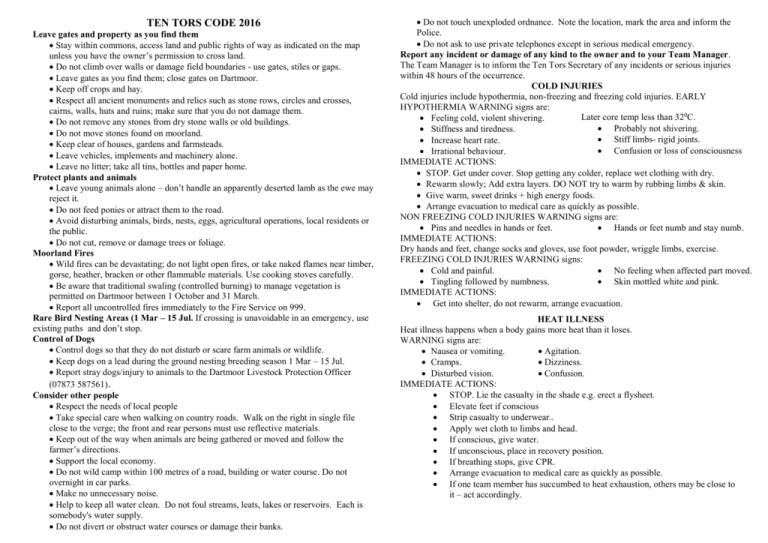
TEN TORS CODE 2016 Leave gates and property as you find them Stay within commons, access land and public rights of way as indicated on the map unless you have the owner’s permission to cross land. Do not climb over walls or damage field boundaries - use gates, stiles or gaps. Leave gates as you find them; close gates on Dartmoor. Keep off crops and hay. Respect all ancient monuments and relics such as stone rows, circles and crosses, cairns, walls, huts and ruins; make sure that you do not damage them. Do not remove any stones from dry stone walls or old buildings. Do not move stones found on moorland. Keep clear of houses, gardens and farmsteads. Leave vehicles, implements and machinery alone. Leave no litter; take all tins, bottles and paper home. Protect plants and animals Leave young animals alone – don’t handle an apparently deserted lamb as the ewe may reject it. Do not feed ponies or attract them to the road. Avoid disturbing animals, birds, nests, eggs, agricultural operations, local residents or the public. Do not cut, remove or damage trees or foliage. Moorland Fires Wild fires can be devastating; do not light open fires, or take naked flames near timber, gorse, heather, bracken or other flammable materials. Use cooking stoves carefully. Be aware that traditional swaling (controlled burning) to manage vegetation is permitted on Dartmoor between 1 October and 31 March. Report all uncontrolled fires immediately to the Fire Service on 999. Rare Bird Nesting Areas (1 Mar – 15 Jul. If crossing is unavoidable in an emergency, use existing paths and don’t stop. Control of Dogs Control dogs so that they do not disturb or scare farm animals or wildlife. Keep dogs on a lead during the ground nesting breeding season 1 Mar – 15 Jul. Report stray dogs/injury to animals to the Dartmoor Livestock Protection Officer (07873 587561). Consider other people Respect the needs of local people Take special care when walking on country roads. Walk on the right in single file close to the verge; the front and rear persons must use reflective materials. Keep out of the way when animals are being gathered or moved and follow the farmer’s directions. Support the local economy. Do not wild camp within 100 metres of a road, building or water course. Do not overnight in car parks. Make no unnecessary noise. Help to keep all water clean. Do not foul streams, leats, lakes or reservoirs. Each is somebody's water supply. Do not divert or obstruct water courses or damage their banks. Do not touch unexploded ordnance. Note the location, mark the area and inform the Police. Do not ask to use private telephones except in serious medical emergency. Report any incident or damage of any kind to the owner and to your Team Manager. The Team Manager is to inform the Ten Tors Secretary of any incidents or serious injuries within 48 hours of the occurrence. COLD INJURIES Cold injuries include hypothermia, non-freezing and freezing cold injuries. EARLY HYPOTHERMIA WARNING signs are: Later core temp less than 320C. Feeling cold, violent shivering. Probably not shivering. Stiffness and tiredness. Stiff limbs- rigid joints. Increase heart rate. Confusion or loss of consciousness Irrational behaviour. IMMEDIATE ACTIONS: STOP. Get under cover. Stop getting any colder, replace wet clothing with dry. Rewarm slowly; Add extra layers. DO NOT try to warm by rubbing limbs & skin. Give warm, sweet drinks + high energy foods. Arrange evacuation to medical care as quickly as possible. NON FREEZING COLD INJURIES WARNING signs are: Pins and needles in hands or feet. Hands or feet numb and stay numb. IMMEDIATE ACTIONS: Dry hands and feet, change socks and gloves, use foot powder, wriggle limbs, exercise. FREEZING COLD INJURIES WARNING signs: Cold and painful. No feeling when affected part moved. Tingling followed by numbness. Skin mottled white and pink. IMMEDIATE ACTIONS: Get into shelter, do not rewarm, arrange evacuation. HEAT ILLNESS Heat illness happens when a body gains more heat than it loses. WARNING signs are: Nausea or vomiting. Agitation. Cramps. Dizziness. Disturbed vision. Confusion. IMMEDIATE ACTIONS: STOP. Lie the casualty in the shade e.g. erect a flysheet. Elevate feet if conscious Strip casualty to underwear.. Apply wet cloth to limbs and head. If conscious, give water. If unconscious, place in recovery position. If breathing stops, give CPR. Arrange evacuation to medical care as quickly as possible. If one team member has succumbed to heat exhaustion, others may be close to it – act accordingly. MOORLAND HAZARDS TEN TORS 2016 Flooded Rivers. Dartmoor’s rivers rise rapidly after rain. Crossing a swift-flowing flooded river can be hazardous and should not be attempted unless safe to do so. Unbuckle your rucksack waist belt & chest strap before crossing. If there is no bridge nearby, go upstream to a safe crossing point and adjust your route to the next Check Point or use your Escape Route. AIDE MEMOIRE FOR TEAMS (THE GREEN CARD) Adder Bites. Adders are plentiful on Dartmoor but are timid and move away when you approach. The effect of a bite may be painful but is NOT DANGEROUS. Treatment is: Reassure the casualty; lay them down and keep still. Check breathing and heartbeat for shock; if not breathing give CPR. Immobilise the affected limb as for fracture. Seek help and obtain medical assistance. Thunderstorms. To avoid lightning strike, sit on your rucksack in the open with your knees up and hands in lap. The rucksack will provide insulation from the ground provided that no part of your body touches the ground. Unexploded Ammunition. Unexploded ordnance surfaces occasionally. As it may be DANGEROUS, DO NOT TOUCH. Mark the area and report the location to the Police. RESCUE INFORMATION Lost !! If you think you are lost: Check your compass bearing and map; if possible back-track to a known position, or If you think you are near the edge of the moor, walk on a fixed bearing until you can identify your position. Failing the above, find a stream and follow it DOWN until you reach a recognisable point. Casualty !! Telephone for assistance. Be prepared to give your team name and number, the injury, your grid reference and description of your location. If you cannot make contact, at least one team member must remain with the casualty whilst at least 2 other team members seek help. Before moving off, note carefully the location of the casualty, the colour of the tent, and anything else that may assist a search team. REMEMBER THE INTERNATIONAL DISTRESS SIGNALS Distress: Six short blasts or torch flashes, wait 1 minute and repeat. Acknowledgement: Three short blasts wait 1 min and repeat. WARNING Failure to observe the Ten Tors Code may disqualify your team from participating in the Expedition and could debar your establishment from entering in future years. Establishment Name: ………………………………………………………… Establishment Code: ……………………………………………………… Team Manager’s Telephone Contact Details: ………………………………………… Team ‘Off-Moor’ Telephone Contact Details: …………………………………..…. Police Emergency 999 or 112 via all networks. Non-Emergency 101. Dartmoor is a unique area of countryside and an extremely valuable part of our national heritage: hence its status as a National Park. However, every acre of land - even the open moor land - is owned by somebody and helps to provide a livelihood for the local farmers. You must obey the TEN TORS CODE so as to CARE for the countryside and be CONSIDERATE of other users. Dartmoor can be beautiful: it can also be dangerous, especially for the inexperienced. Its weather changes frequently and suddenly, and within a few hours one can experience sun, mist, rain, hail and high winds. At any time between October and May, snow may bring conditions of frightening severity. During Spring and Summer, cloudless skies can send the temperatures soaring. Wet, windy and cold conditions may give rise to EXPOSURE: hot and sultry conditions may result in HEAT EXHAUSTION. This Card contains advice on treatment and on avoiding other hazards and difficulties on the Moor. THIS CARD IS TO BE CARRIED during training by Team Managers, Group Leaders, Group Assistants, and by the Walking Group Leader and deputy and during the Challenge by Team Leaders and their deputy. Its contents must be read and observed by ALL those involved in training for and participating in Ten Tors. IT MUST BE PRODUCED AND SHOWN to any farmer, policeman, National Park Ranger, Ten Tors Official or Rescue Group Leader who asks for it.
